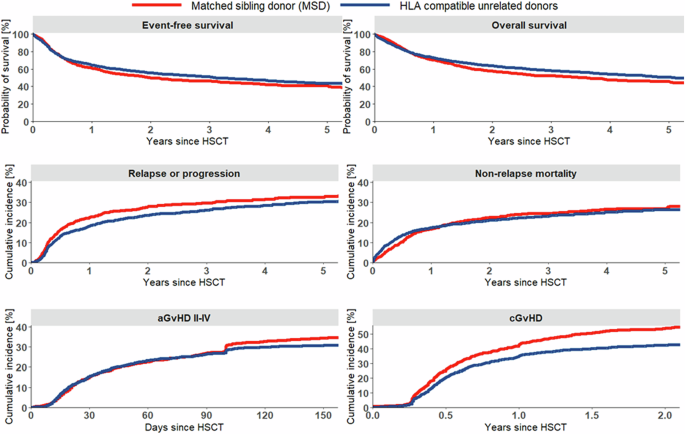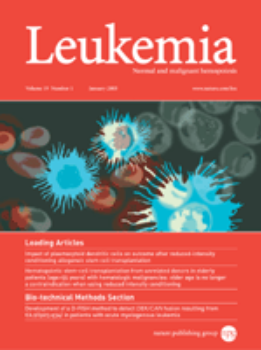Young unrelated donors confer a survival advantage for patients with myeloid malignancies compared to older siblings
IF 13.4
1区 医学
Q1 HEMATOLOGY
引用次数: 0
Abstract
Donor age is one factor to optimize allogeneic hematopoietic cell transplantation (alloHCT). Therefore, we investigated whether young unrelated donors (UD) provide a benefit for older patients with myeloid malignancies compared to HLA-identical sibling donors (MSD). We performed a retrospective registry study on patients ≥50 years who received a first alloHCT between 2010 and 2020. We compared event-free survival (EFS) of patients who were transplanted from MSD aged ≥50 years versus UD aged ≤35 years who were HLA-compatible for HLA-A, -B, -C, and -DRB1. In total, we analyzed data from 3460 patients. With multivariable adjustment EFS (HR 0.86, p = 0.003), OS (HR 0.82, p < 0.001), and risk of relapse (HR 0.84, p = 0.018) were significantly better for HLA-compatible UD compared to MSD. No survival advantage was found, when UD with unfavorable sex or CMV constellation were compared to MSD with favorable constellations. In a meta-analysis on 9905 patients with myeloid malignancies, including ours, we found reduced risk of relapse (pooled HR 0.78, p = 0.006) and better EFS (pooled HR 0.89, p < 0.001) for young matched UD versus MSD. To select young HLA-compatible UD over older MSD may reduce relapse risk and improve survival for older patients with myeloid malignancies.


与年长的兄弟姐妹相比,年轻的非亲属供体赋予骨髓恶性肿瘤患者生存优势
供体年龄是优化同种异体造血细胞移植(allogeneic hematopoietic cell transplantation, alloHCT)的一个因素。因此,我们研究了与hla相同的兄弟姐妹供体(MSD)相比,年轻的非亲属供体(UD)是否对老年髓系恶性肿瘤患者有益。我们对2010年至2020年间首次接受同种异体hct的≥50岁患者进行了回顾性登记研究。我们比较了年龄≥50岁的MSD移植患者与年龄≤35岁、HLA-A、-B、-C和-DRB1兼容的UD移植患者的无事件生存期(EFS)。我们总共分析了3460名患者的数据。多变量调整后,与MSD相比,hla相容UD的EFS (HR 0.86, p = 0.003)、OS (HR 0.82, p < 0.001)和复发风险(HR 0.84, p = 0.018)明显更好。当性别不利或CMV星座的UD与星座有利的MSD进行比较时,没有发现生存优势。在一项对9905例髓系恶性肿瘤患者(包括我们的患者)的荟萃分析中,我们发现年轻匹配的UD与MSD相比,复发风险降低(合并HR 0.78, p = 0.006), EFS更好(合并HR 0.89, p < 0.001)。选择年轻的hla兼容UD而不是老年的MSD可以降低老年髓系恶性肿瘤患者的复发风险并提高生存率。
本文章由计算机程序翻译,如有差异,请以英文原文为准。
求助全文
约1分钟内获得全文
求助全文
来源期刊

Leukemia
医学-血液学
CiteScore
18.10
自引率
3.50%
发文量
270
审稿时长
3-6 weeks
期刊介绍:
Title: Leukemia
Journal Overview:
Publishes high-quality, peer-reviewed research
Covers all aspects of research and treatment of leukemia and allied diseases
Includes studies of normal hemopoiesis due to comparative relevance
Topics of Interest:
Oncogenes
Growth factors
Stem cells
Leukemia genomics
Cell cycle
Signal transduction
Molecular targets for therapy
And more
Content Types:
Original research articles
Reviews
Letters
Correspondence
Comments elaborating on significant advances and covering topical issues
 求助内容:
求助内容: 应助结果提醒方式:
应助结果提醒方式:


